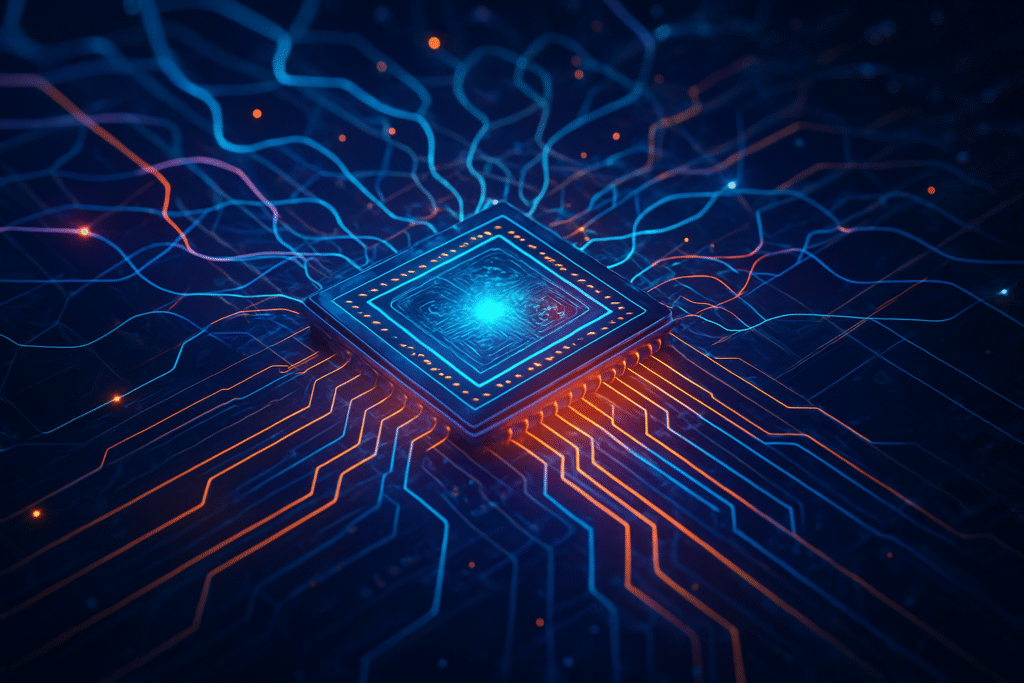Financial News
The Silicon Revolution: New AI Chip Architectures Ignite an ‘AI Supercycle’ and Redefine Computing

The artificial intelligence landscape is undergoing a profound transformation, heralded by an unprecedented "AI Supercycle" in chip design. As of October 2025, the demand for specialized AI capabilities—spanning generative AI, high-performance computing (HPC), and pervasive edge AI—has propelled the AI chip market to an estimated $150 billion in sales this year alone, representing over 20% of the total chip market. This explosion in demand is not merely driving incremental improvements but fostering a paradigm shift towards highly specialized, energy-efficient, and deeply integrated silicon solutions, meticulously engineered to accelerate the next generation of intelligent systems.
This wave of innovation is marked by aggressive performance scaling, groundbreaking architectural approaches, and strategic positioning by both established tech giants and nimble startups. From wafer-scale processors to inference-optimized TPUs and brain-inspired neuromorphic chips, the immediate significance of these breakthroughs lies in their collective ability to deliver the extreme computational power required for increasingly complex AI models, while simultaneously addressing critical challenges in energy efficiency and enabling AI's expansion across a diverse range of applications, from massive data centers to ubiquitous edge devices.
Unpacking the Technical Marvels: A Deep Dive into Next-Gen AI Silicon
The technical landscape of AI chip design is a crucible of innovation, where diverse architectures are being forged to meet the unique demands of AI workloads. Leading the charge, Nvidia Corporation (NASDAQ: NVDA) has dramatically accelerated its GPU roadmap to an annual update cycle, introducing the Blackwell Ultra GPU for production in late 2025, promising 1.5 times the speed of its base Blackwell model. Looking further ahead, the Rubin Ultra GPU, slated for a late 2027 release, is projected to be an astounding 14 times faster than Blackwell. Nvidia's "One Architecture" strategy, unifying hardware and its CUDA software ecosystem across data centers and edge devices, underscores a commitment to seamless, scalable AI deployment. This contrasts with previous generations that often saw more disparate development cycles and less holistic integration, allowing Nvidia to maintain its dominant market position by offering a comprehensive, high-performance solution.
Meanwhile, Alphabet Inc. (NASDAQ: GOOGL) is aggressively advancing its Tensor Processing Units (TPUs), with a notable shift towards inference optimization. The Trillium (TPU v6), announced in May 2024, significantly boosted compute performance and memory bandwidth. However, the real game-changer for large-scale inferential AI is the Ironwood (TPU v7), introduced in April 2025. Specifically designed for "thinking models" and the "age of inference," Ironwood delivers twice the performance per watt compared to Trillium, boasts six times the HBM capacity (192 GB per chip), and scales to nearly 10,000 liquid-cooled chips. This rapid iteration and specialized focus represent a departure from earlier, more general-purpose AI accelerators, directly addressing the burgeoning need for efficient deployment of generative AI and complex AI agents.
Advanced Micro Devices, Inc. (NASDAQ: AMD) is also making significant strides with its Instinct MI350 series GPUs, which have already surpassed ambitious energy efficiency goals. Their upcoming MI400 line, expected in 2026, and the "Helios" rack-scale AI system previewed at Advancing AI 2025, highlight a commitment to open ecosystems and formidable performance. Helios integrates MI400 GPUs with EPYC "Venice" CPUs and Pensando "Vulcano" NICs, supporting the open UALink interconnect standard. This open-source approach, particularly with its ROCm software platform, stands in contrast to Nvidia's more proprietary ecosystem, offering developers and enterprises greater flexibility and potentially lower vendor lock-in. Initial reactions from the AI community have been largely positive, recognizing the necessity of diverse hardware options and the benefits of an open-source alternative.
Beyond these major players, Intel Corporation (NASDAQ: INTC) is pushing its Gaudi 3 AI accelerators for data centers and spearheading the "AI PC" movement, aiming to ship over 100 million AI-enabled processors by 2025. Cerebras Systems continues its unique wafer-scale approach with the WSE-3, a single chip boasting 4 trillion transistors and 125 AI petaFLOPS, designed to eliminate communication bottlenecks inherent in multi-GPU systems. Furthermore, the rise of custom AI chips from tech giants like OpenAI, Microsoft Corporation (NASDAQ: MSFT), Amazon.com, Inc. (NASDAQ: AMZN), and Meta Platforms, Inc. (NASDAQ: META), often fabricated by Taiwan Semiconductor Manufacturing Company Limited (NYSE: TSM), signifies a strategic move towards highly optimized, in-house solutions tailored for specific workloads. These custom chips, such as Google's Axion Arm-based CPU and Microsoft's Azure Maia 100, represent a critical evolution, moving away from off-the-shelf components to bespoke silicon for competitive advantage.
Industry Tectonic Plates Shift: Competitive Implications and Market Dynamics
The relentless innovation in AI chip architectures is profoundly reshaping the competitive landscape for AI companies, tech giants, and startups alike. Nvidia Corporation (NASDAQ: NVDA) stands to continue its reign as the primary beneficiary of the AI supercycle, with its accelerated roadmap and integrated ecosystem making its Blackwell and upcoming Rubin architectures indispensable for hyperscale cloud providers and enterprises running the largest AI models. Its aggressive sales of Blackwell GPUs to top U.S. cloud service providers—nearly tripling Hopper sales—underscore its entrenched position and the immediate demand for its cutting-edge hardware.
Alphabet Inc. (NASDAQ: GOOGL) is leveraging its specialized TPUs, particularly the inference-optimized Ironwood, to enhance its own cloud infrastructure and AI services. This internal optimization allows Google Cloud to offer highly competitive pricing and performance for AI workloads, potentially attracting more customers and reducing its operational costs for running massive AI models like Gemini successors. This strategic vertical integration could disrupt the market for third-party inference accelerators, as Google prioritizes its proprietary solutions.
Advanced Micro Devices, Inc. (NASDAQ: AMD) is emerging as a significant challenger, particularly for companies seeking alternatives to Nvidia's ecosystem. Its open-source ROCm platform and robust MI350/MI400 series, coupled with the "Helios" rack-scale system, offer a compelling proposition for cloud providers and enterprises looking for flexibility and potentially lower total cost of ownership. This competitive pressure from AMD could lead to more aggressive pricing and innovation across the board, benefiting consumers and smaller AI labs.
The rise of custom AI chips from tech giants like OpenAI, Microsoft Corporation (NASDAQ: MSFT), Amazon.com, Inc. (NASDAQ: AMZN), and Meta Platforms, Inc. (NASDAQ: META) represents a strategic imperative to gain greater control over their AI destinies. By designing their own silicon, these companies can optimize chips for their specific AI workloads, reduce reliance on external vendors like Nvidia, and potentially achieve significant cost savings and performance advantages. This trend directly benefits specialized chip design and fabrication partners such as Broadcom Inc. (NASDAQ: AVGO) and Marvell Technology, Inc. (NASDAQ: MRVL), who are securing multi-billion dollar orders for custom AI accelerators. It also signifies a potential disruption to existing merchant silicon providers as a portion of the market shifts to in-house solutions, leading to increased differentiation and potentially more fragmented hardware ecosystems.
Broader Horizons: AI's Evolving Landscape and Societal Impacts
These innovations in AI chip architectures mark a pivotal moment in the broader artificial intelligence landscape, solidifying the trend towards specialized computing. The shift from general-purpose CPUs and even early, less optimized GPUs to purpose-built AI accelerators and novel computing paradigms is akin to the evolution seen in graphics processing or specialized financial trading hardware—a clear indication of AI's maturation as a distinct computational discipline. This specialization is enabling the development and deployment of larger, more complex AI models, particularly in generative AI, which demands unprecedented levels of parallel processing and memory bandwidth.
The impacts are far-reaching. On one hand, the sheer performance gains from architectures like Nvidia's Rubin Ultra and Google's Ironwood are directly fueling the capabilities of next-generation large language models and multi-modal AI, making previously infeasible computations a reality. On the other hand, the push towards "AI PCs" by Intel Corporation (NASDAQ: INTC) and the advancements in neuromorphic and analog computing are democratizing AI by bringing powerful inference capabilities to the edge. This means AI can be embedded in more devices, from smartphones to industrial sensors, enabling real-time, low-power intelligence without constant cloud connectivity. This proliferation promises to unlock new applications in IoT, autonomous systems, and personalized computing.
However, this rapid evolution also brings potential concerns. The escalating computational demands, even with efficiency improvements, raise questions about the long-term energy consumption of global AI infrastructure. Furthermore, while custom chips offer strategic advantages, they can also lead to new forms of vendor lock-in or increased reliance on a few specialized fabrication facilities like Taiwan Semiconductor Manufacturing Company Limited (NYSE: TSM). The high cost of developing and manufacturing these cutting-edge chips could also create a significant barrier to entry for smaller players, potentially consolidating power among a few well-resourced tech giants. This period can be compared to the early 2010s when GPUs began to be recognized for their general-purpose computing capabilities, fundamentally changing the trajectory of scientific computing and machine learning. Today, we are witnessing an even more granular specialization, optimizing silicon down to the very operations of neural networks.
The Road Ahead: Anticipating Future Developments and Challenges
Looking ahead, the trajectory of AI chip innovation suggests several key developments in the near and long term. In the immediate future, we can expect the performance race to intensify, with Nvidia Corporation (NASDAQ: NVDA), Alphabet Inc. (NASDAQ: GOOGL), and Advanced Micro Devices, Inc. (NASDAQ: AMD) continually pushing the boundaries of raw computational power and memory bandwidth. The widespread adoption of HBM4, with its significantly increased capacity and speed, will be crucial in supporting ever-larger AI models. We will also see a continued surge in custom AI chip development by major tech companies, further diversifying the hardware landscape and potentially leading to more specialized, domain-specific accelerators.
Over the longer term, experts predict a move towards increasingly sophisticated hybrid architectures that seamlessly integrate different computing paradigms. Neuromorphic and analog computing, currently niche but rapidly advancing, are poised to become mainstream for edge AI applications where ultra-low power consumption and real-time learning are paramount. Advanced packaging technologies, such as chiplets and 3D stacking, will become even more critical for overcoming physical limitations and enabling unprecedented levels of integration and performance. These advancements will pave the way for hyper-personalized AI experiences, truly autonomous systems, and accelerated scientific discovery across fields like drug development and material science.
However, significant challenges remain. The software ecosystem for these diverse architectures needs to mature rapidly to ensure ease of programming and broad adoption. Power consumption and heat dissipation will continue to be critical engineering hurdles, especially as chips become denser and more powerful. Scaling AI infrastructure efficiently beyond current limits will require novel approaches to data center design and cooling. Experts predict that while the exponential growth in AI compute will continue, the emphasis will increasingly shift towards holistic software-hardware co-design and the development of open, interoperable standards to foster innovation and prevent fragmentation. The competition from open-source hardware initiatives might also gain traction, offering more accessible alternatives.
A New Era of Intelligence: Concluding Thoughts on the AI Chip Revolution
In summary, the current "AI Supercycle" in chip design, as evidenced by the rapid advancements in October 2025, is fundamentally redefining the bedrock of artificial intelligence. We are witnessing an unparalleled era of specialization, where chip architectures are meticulously engineered for specific AI workloads, prioritizing not just raw performance but also energy efficiency and seamless integration. From Nvidia Corporation's (NASDAQ: NVDA) aggressive GPU roadmap and Alphabet Inc.'s (NASDAQ: GOOGL) inference-optimized TPUs to Cerebras Systems' wafer-scale engines and the burgeoning field of neuromorphic and analog computing, the diversity of innovation is staggering. The strategic shift by tech giants towards custom silicon further underscores the critical importance of specialized hardware in gaining a competitive edge.
This development is arguably one of the most significant milestones in AI history, providing the essential computational horsepower that underpins the explosive growth of generative AI, the proliferation of AI to the edge, and the realization of increasingly sophisticated intelligent systems. Without these architectural breakthroughs, the current pace of AI advancement would be unsustainable. The long-term impact will be a complete reshaping of the tech industry, fostering new markets for AI-powered products and services, while simultaneously prompting deeper considerations around energy sustainability and ethical AI development.
In the coming weeks and months, industry observers should keenly watch for the next wave of product launches from major players, further announcements regarding custom chip collaborations, the traction gained by open-source hardware initiatives, and the ongoing efforts to improve the energy efficiency metrics of AI compute. The silicon revolution for AI is not merely an incremental step; it is a foundational transformation that will dictate the capabilities and reach of artificial intelligence for decades to come.
This content is intended for informational purposes only and represents analysis of current AI developments.
TokenRing AI delivers enterprise-grade solutions for multi-agent AI workflow orchestration, AI-powered development tools, and seamless remote collaboration platforms. For more information, visit https://www.tokenring.ai/.
More News
View More




Recent Quotes
View More
Quotes delayed at least 20 minutes.
By accessing this page, you agree to the Privacy Policy and Terms Of Service.



